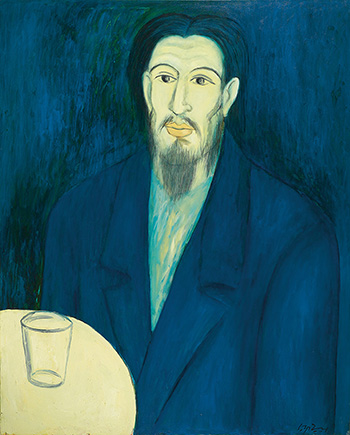EXHIBITED:
Two Taiwan Artists, ABN AMRO Bank, Monaco,
14 December 1998-28 February 1999.
Menton, France, Musee de Menton, May-June 1999.
Two Contemporary Taiwanese Artists, Plum Blossoms Gallery, New York, USA, , 3-24 November 2001.
Catalogue Note:
Throughout the history of both Chinese and Western art, portraiture has remained a consistently popular genre. The clothing worn by the people portrayed, and the background scenes, help to give as a feel for the era in which the portrait was painted, and portraits from the past give people living in today’s world a window onto what life was like for the portrait subjects and their contemporaries. In both the Chinese and Western portraiture traditions, realism gradually became a core aspect of portrait painting; in the West, the Renaissance ushered in a new era in which portraiture grew increasingly popular and portraits grew ever more realistic, while in China the portraits painted during the Tang Dynasty may seem somewhat expressionist, but they still feature precise, detailed depiction of facial features.
Chiu Ya-tsai’s portraits have an indefinable quality to them that resembles both Chinese and Western styles of portraiture. His flat backgrounds with their bold, powerful use of color seem to reflect the attitude towards color of the Fauvists, but Chiu’s paintings are also characterized by effective use of the traditional Chinese baimiao monochromatic brush-line technique, in which simple lines delineate the facial features, bringing across the spiritual essence of the person portrayed without being constrained by formal conventions or overburdened with excessive detail. The figure shown in this particular painting, with his almond-shaped eyes, arched eyebrows and red lips, appears to be gazing calmly into the distance, and yet the contrast between his white skin and the blue surrounding it hints at a slight sense of emotional expression.
Chiu Ya-tsai’s artistic talent derived in no small part from his own sorrows; he once commented that all of the figures depicted in his paintings had something of himself about them: the struggling artist, the rootless wanderer, or the unsuccessful businessman. These lonely images provide the viewer with clues as to the artist’s own inner world. A lover of literature who also wrote as a form of self-expression, Chiu was able to condense his feelings into a series of portraits. The individuals shown in these paintings are never wholly broken down by life; although sorrow or sadness may appear on their faces, they always maintain a steady calmness in the face of the problems that the world throws at them, and the overall effect is one of refined, gentlemanly bearing. The artistic lexicon of Chiu Ya-tsai’s paintings reflects in microcosm the life of the artist himself. Through his brushstrokes, Chiu was able to express his own identity, becoming a “storyteller” whose own tale is told through the figures in his portraits. It was precisely this lonely, unique spirit that gave Chiu Ya-tsai’s art its power.
